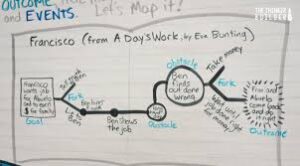Creating compelling characters is at the heart of any great story. Characters are the lifeblood of a narrative, driving the plot forward and engaging readers emotionally. Developing well-rounded and believable characters can be challenging, but using creative writing exercises is an effective way to explore and deepen your characters. In this guide, we’ll explore how to use creative writing exercises to develop rich, multidimensional characters that captivate your audience.
Why Character Development is Crucial

Before diving into specific exercises, it’s essential to understand why character development is critical. Well-developed characters:
- Drive the Plot: Characters’ decisions and actions move the story forward, creating tension and progression.
- Engage Readers: Readers connect with relatable, dynamic characters, making them invested in the story.
- Enhance Themes: Characters embody themes and messages, adding depth to the narrative.
- Create Emotional Impact: Readers experience a range of emotions through characters, making the story memorable and impactful.
Creative Writing Exercises for Character Development
Here are some effective creative writing exercises to help you develop your characters:
1. Character Interviews
Objective: To gain a deeper understanding of your character’s personality, motivations, and background.
How-To: Write an interview between you (the writer) and your character. Prepare a list of questions that cover various aspects of their life, such as:
- What is your greatest fear?
- What is your biggest regret?
- Describe a significant event from your past.
- How do you view yourself versus how others see you?
Example: For a character who is a detective, you might ask about their childhood influences, their views on justice, or how they cope with the stresses of their job.
Benefit: This exercise helps you get inside your character’s head and explore their inner world, making them more authentic and relatable.
2. Character Backstory Creation
Objective: To build a detailed history that shapes your character’s current actions and beliefs.
How-To: Create a detailed timeline or narrative of your character’s life before the events of your story. Include:
- Early Life: Family background, childhood experiences, education.
- Formative Events: Key moments that influenced their personality and choices.
- Career and Relationships: Important relationships and career milestones.
Example: If your character is a former soldier turned private investigator, their backstory might include military experiences, a significant loss, and the transition to civilian life.
Benefit: A well-developed backstory provides context for your character’s behavior and motivations, making their actions in the story more understandable.
3. The “What If?” Scenario

Objective: To explore how your character reacts to unusual or extreme situations.
How-To: Place your character in hypothetical situations that are outside their usual experience. Consider:
- What if your character won a million dollars overnight?
- What if your character had to live in a different time period?
- What if your character discovered a deep family secret?
Example: Imagine your character, a reserved librarian, suddenly becomes a celebrity. How would they handle fame, and how would it affect their interactions with others?
Benefit: This exercise reveals how your character adapts to new challenges and stresses, providing insights into their resilience, values, and adaptability.
4. Dialogue Writing
Objective: To refine your character’s voice and interactions with others.
How-To: Write a scene featuring your character in a conversation with another character. Focus on:
- Voice: How does your character speak? What’s their tone, language, and style?
- Conflict: What are the tensions or disagreements in the dialogue?
- Subtext: What are they really saying versus what’s on the surface?
Example: Write a heated argument between your character and a friend over a personal betrayal. How does each character express their emotions, and what does this reveal about their relationship?
Benefit: Dialogue exercises help you understand how your character communicates and interacts with others, highlighting their personality traits and social dynamics.
5. Character Descriptions from Others’ Perspectives
Objective: To understand how your character is perceived by others.
How-To: Write descriptions of your character from the perspective of other characters in your story. Consider:
- How does a close friend view your character?
- What do colleagues think of them?
- How do strangers perceive them?
Example: Describe your character through the eyes of their boss, a family member, and a casual acquaintance. Each perspective will offer a unique take on their personality and appearance.
Benefit: This exercise reveals different facets of your character and how they are perceived by others, adding depth to their interactions and relationships.
6. Emotional Response Writing
Objective: To explore how your character deals with various emotions.
How-To: Write short scenes or diary entries from your character’s perspective as they experience intense emotions such as:
- Joy: How does your character celebrate a personal victory?
- Fear: What are their physical and emotional reactions to a threat?
- Sadness: How do they cope with a loss or disappointment?
Example: Write about how your character handles receiving heartbreaking news. Focus on their internal monologue, physical reactions, and coping mechanisms.
Benefit: This exercise helps you portray your character’s emotional range more authentically, making their experiences relatable and engaging.
7. Character Goal and Conflict Mapping

Objective: To clarify your character’s objectives and the obstacles they face.
How-To: Create a map or list detailing:
- Goals: What does your character want to achieve, both short-term and long-term?
- Conflicts: What obstacles are preventing them from reaching their goals?
- Motivations: Why are these goals important to them?
Example: If your character’s goal is to solve a mystery, map out the clues they need, the suspects they must interrogate, and the personal stakes involved.
Benefit: This exercise helps structure your character’s journey and ensures that their goals and conflicts drive the narrative effectively.
Incorporating Exercises into Your Writing Routine
Integrating these exercises into your writing routine can significantly enhance your character development process. Here are some tips for making the most of these exercises:
- Consistency: Set aside regular time for these exercises, such as weekly or bi-weekly sessions.
- Experimentation: Try different exercises to see which ones yield the best insights for your characters.
- Reflection: Regularly review and refine the results of these exercises as your story evolves.
- Integration: Use insights gained from exercises to influence your character’s actions, dialogue, and development throughout the story.
Conclusion
Creative writing exercises are invaluable tools for developing well-rounded, compelling characters. By exploring your characters through interviews, backstories, hypothetical scenarios, dialogue, and more, you gain deeper insights into their motivations, behaviors, and interactions. These exercises not only enhance your understanding of your characters but also enrich your storytelling, making your narrative more engaging and relatable.
As you embark on your writing journey, remember that character development is an ongoing process. Use these exercises to continually deepen your characters and create a story that resonates with readers on a profound level. Happy writing!



